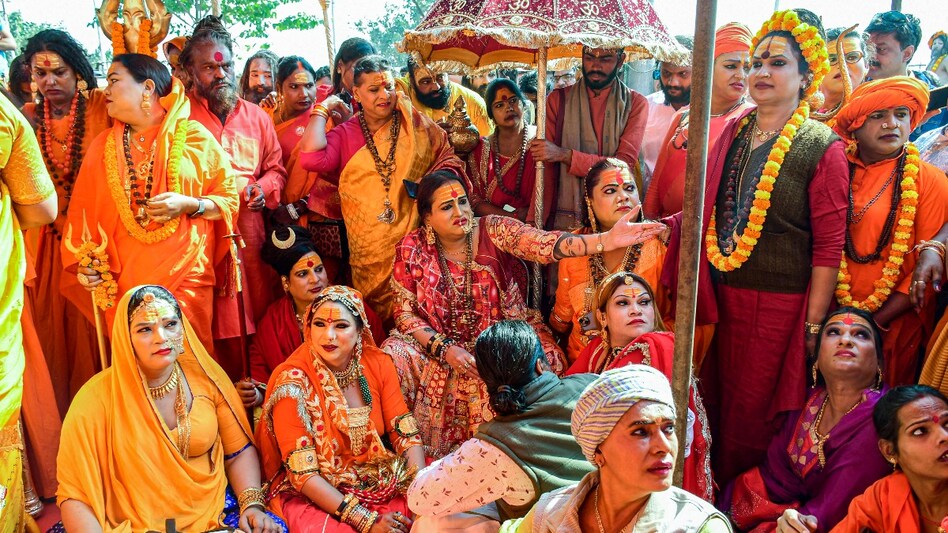 Acharya MahaMandleshwar, Kinnar Akhada Laxmi Narayan Tripathi in a procession during the first ‘royal entry’ for the Maha Kumbh Mela 2025 festival in Prayagraj on December 14.
Acharya MahaMandleshwar, Kinnar Akhada Laxmi Narayan Tripathi in a procession during the first ‘royal entry’ for the Maha Kumbh Mela 2025 festival in Prayagraj on December 14.  Acharya MahaMandleshwar, Kinnar Akhada Laxmi Narayan Tripathi in a procession during the first ‘royal entry’ for the Maha Kumbh Mela 2025 festival in Prayagraj on December 14.
Acharya MahaMandleshwar, Kinnar Akhada Laxmi Narayan Tripathi in a procession during the first ‘royal entry’ for the Maha Kumbh Mela 2025 festival in Prayagraj on December 14. The Maha Kumbh Mela, often celebrated as the largest spiritual gathering in the world, is a grand expression of devotion, faith and ancient traditions. In 2025, from January 13 to February 26, Prayagraj will once again host this remarkable event, drawing millions of pilgrims and visitors to experience a profound display of faith, unity and India’s spiritual legacy.
Artificial intelligence-powered cameras will be deployed at the Maha Kumbh Mela 2025 to ensure a precise count of the millions of devotees attending one of the world’s largest religious gatherings. With over 40 crore people expected to participate, the event is set to break records. The Uttar Pradesh government aims to achieve an impressive 95 percent accuracy in the headcount by utilising AI-based crowd density algorithms.
According to the state government, the integration of cutting-edge systems will ensure that every devotee is counted, setting a new global standard in crowd management for such large-scale events.
The Uttar Pradesh administration is determined to achieve the “largest headcount in the world” leveraging AI and other innovative techniques to accomplish this milestone.
The government acknowledged that while past Kumbh gatherings in Prayagraj have seen massive crowds, the lack of accurate technology for counting them posed challenges. To overcome this, AI-enabled cameras will be extensively used to ensure precise headcount data.
“These advanced cameras will provide real-time updates every minute, focusing primarily on tracking devotees at the ghats,” the statement explained. The system will operate from 3 am to 7 pm, the peak hours for bathing rituals.
Similar technologies were successfully tested during the Magh Mela, which proved their reliability. With these enhancements, the headcount at the Maha Kumbh 2025 is expected to reach up to 95 percent accuracy.
Divisional Commissioner Vijay Vishwas Pant confirmed that over 40 crore people are anticipated to attend, making it a historic event. Special measures have been implemented to manage this unprecedented crowd.
“Around 744 temporary CCTV cameras will be set up at 200 locations within the fairgrounds, and 1,107 permanent CCTV cameras have been installed across 268 city locations. Additionally, 720 cameras will be deployed in over 100 parking areas to ensure seamless monitoring and crowd management,” he said.
Dedicated viewing centres have also been established at the Integrated Command and Control Centre (ICCC), Police Line Control Room, and in the Arail and Jhunsi regions to support effective monitoring of the large gathering.
By utilising AI-driven crowd density algorithms, authorities aim to accurately count attendees, while AI-based systems will provide real-time alerts to assist officials in efficiently tracking and managing devotees throughout the event.
Experts working on headcount modelling at the ICCC emphasised the importance of tracking the turnaround cycle to avoid double-counting.
The turnaround cycle measures how long a devotee spends at the ghat, ensuring accurate data collection. Using the Cochran formula, the system estimates 20 lakh devotees on non-peak days and up to 10 crore on peak days.
Held every 12 years, the Maha Kumbh Mela 2025 will take place from January 13 to February 26. Devotees from across India will gather at Prayagraj’s sacred Triveni Sangam, where the Ganga, Yamuna, and the mythical Saraswati rivers meet.
To support the event, the state government has created a new district, Mahakumbh Nagar, which includes 66 villages across four tehsils — Sadar, Soraon, Phulpur and Karchhana.